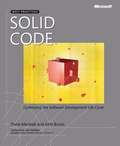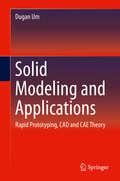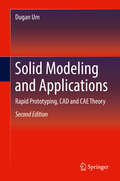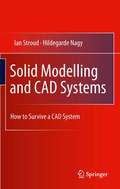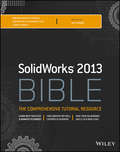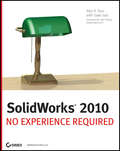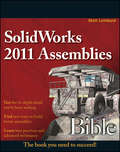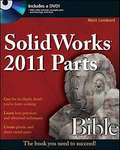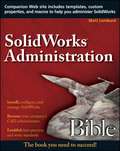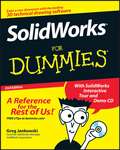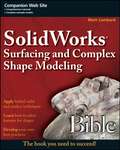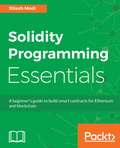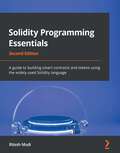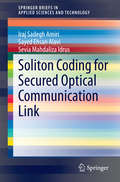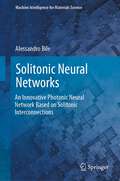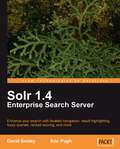- Table View
- List View
Solid Code
by Donis Marshall John BrunoGet best-in-class engineering practices to help you write more-robust, bug-free code. Two Microsoft .NET development experts share real-world examples and proven methods for optimizing the software development life cycle--from avoiding costly programming pitfalls to making your development team more efficient. Managed code developers at all levels will find design, prototyping, implementation, debugging, and testing tips to boost the quality of their code--today. Optimize each stage of the development process--from design to testing--and produce higher-quality applications. Use metaprogramming to reduce code complexity, while increasing flexibility and maintainability Treat performance as a feature--and manage it throughout the development life cycle Apply best practices for application scalability Employ preventative security measures to ward off malicious attacks Practice defensive programming to catch bugs before run time Incorporate automated builds, code analysis, and testing into the daily engineering process Implement better source-control management and check-in procedures Establish a quality-driven, milestone-based project rhythm--and improve your results!
Solid Modeling and Applications
by Dugan UmThe lessons in this fundamental text equip students with the theory of Computer Assisted Design (CAD), Computer Assisted Engineering (CAE), the essentials of Rapid Prototyping, as well as practical skills needed to apply this understanding in real world design and manufacturing settings. The book includes three main areas: CAD, CAE, and Rapid Prototyping, each enriched with numerous examples and exercises. In the CAD section, Professor Um outlines the basic concept of geometric modeling, Hermite and Bezier Spline curves theory, and 3-dimensional surface theories as well as rendering theory. The CAE section explores mesh generation theory, matrix notion for FEM, the stiffness method, and truss Equations. And in Rapid Prototyping, the author illustrates stereo lithographic theory and introduces popular modern RP technologies. Solid Modeling and Applications: Rapid Prototyping, CAD and CAE Theory is ideal for university students in various engineering disciplines as well as design engineers involved in product design, analysis, and validation.
Solid Modeling and Applications: Rapid Prototyping, Cad And Cae Theory
by Dugan UmThis updated, second edition provides readers with an expanded treatment of the FEM as well as new information on recent trends in rapid prototyping technology. The new edition features more descriptions, exercises, and questions within each chapter. In addition, more in-depth surface theory has been introduced in section four, with particular emphasis in surface theory. Promising cutting edge technologies in the area of rapid prototyping are introduced in section seven, MATLAB-based FEM analysis has been added in section eight, and development of the plan stress and plane strain stiffness equations are introduced as a new chapter. Revised and updated based on student feedback, Solid Modeling and Applications: Rapid Prototyping, CAD and CAE Theory is ideal for university students in various engineering disciplines as well as design engineers involved in product design, analysis, and validation. It equips them with an understanding of the theory and essentials and also with practical skills needed to apply this understanding in real world design and manufacturing settings.
Solid Modelling and CAD Systems
by Hildegarde Nagy Ian StroudSolid Modelling and CAD Systems gives users an insight into the methods and problems associated with CAD systems. It acts as a bridge between users who learn interfaces without understanding how they work and developers who create systems without understanding the needs of the users. The main feature of Solid Modelling and CAD Systems is a logical analysis of the techniques and basic solid modelling methods used in modern CAD systems. The book goes on to describe, among other subjects: two-dimensional shape definition methods,the command interface and graphics,databases and data exchange,early-phase design, andcommand files and command structures. Reading Solid Modelling and CAD Systems will help users understand the limitations of the techniques they are using and will enable practitioners to use CAD systems more efficiently. It is a valuable tool for designers, as well as for advanced undergraduate and postgraduate students. The exercises it contains allow readers to try out different aspects of the subject matter and the book also includes projects that can be used for teaching purposes.
SolidWorks 2009 Bible
by Matt LombardSolidWorks Bible is a comprehensive reference-tutorial that covers the basics, but then quickly ramps up to more advanced level topics. Every feature is thoroughly covered yet written in a way that makes learning this robust program seem non-threatening and uncomplicated. In a market full of books for beginners this is the one book that goes into extensive detail, not just on "how" the software works, but in many cases "why" it works the way it does. The author is well known in the SolidWorks community and uses SolidWorks on a daily basis as his main design tool in his contracting and consulting work. Many topics covered in SolidWorks Bible are not found in any other publication or even documentation directly from SolidWorks.Note: CD-ROM/DVD and other supplementary materials are not included as part of eBook file.
SolidWorks 2010: No Experience Required
by Alex Ruiz Gabi JackThe only continuous, step-by-step tutorial for SolidWorks SolidWorks is a 3D CAD manufacturing software package that has been used to design everything from aerospace robotics to bicycles. This book teaches beginners to use SolidWorks through a step-by-step tutorial, letting you build, document, and present a project while you learn. Tools and functionality are explained in the context of professional, real-world tasks and workflows. You will learn the essential functions and gain the skills to use the software at once. SolidWorks is a popular design software for manufacturing, and this book introduces it in the context of actually creating an object Begins with an overview of SolidWorks conventions and the interface Explains how to create models and drawings, create a revolved part and subassembly, and model parts within a subassembly Explores modification capabilities and drawing and Bill of Materials templates Moves on to top-level assembly models and drawings, Toolbox components and the Design Library, mates, export and printing capabilities, and creating renderings Includes a glossary, a foreword from the SolidWorks product manager, and downloadable tutorial files SolidWorks 2010: No Experience Required quickly turns beginners into confident users of SolidWorks.
SolidWorks 2011 Assemblies Bible
by Matt LombardA fan of the SolidWorks Bible, but want more detail on assemblies? Here you go. SolidWorks fans have long sought more detail on SolidWorks topics, and now you have it. We took our popular SolidWorks Bible, divided it into two books (SolidWorks 2011 Assemblies Bible and SolidWorks 2011 Parts Bible) and packed each new book with a host of items from your wish lists, such as more extensive coverage of the basics, additional tutorials, and expanded coverage of topics largely ignored by other books. This SolidWorks 2011 Assemblies Bible shows you how to organize parts data to create assemblies or subassemblies using the latest version of the 3D solid modeling program, SolidWorks Thoroughly describes best practices and beginning-to-advanced techniques using both video and text Explains and thoroughly covers every assembly function and is written in a way that enables the reader to make better decisions while using the software Written by well-known and well-respected SolidWorks guru Matt Lombard Can stand alone or also with the SolidWorks 2011 Parts Bible for a complete SolidWorks reference set Keep both the SolidWorks 2011 Assemblies Bible and the SolidWorks 2011 Parts Bible on your desk, and you?ll have the best resource set out there on SolidWorks.
SolidWorks 2011 Parts Bible
by Matt LombardLike the SolidWorks Bible, but want more on parts? New version provides greater detail than everSolidWorks fans have long sought more detail and information on SolidWorks topics, and now you have it. We took our popular SolidWorks Bible, divided it into two books (SolidWorks 2011 Parts Bible and SolidWorks 2011 Assemblies Bible) and packed each new book with a host of items from your wish lists, such as more extensive coverage of the basics, additional tutorials, and expanded coverage of topics largely ignored by other books.This SolidWorks Parts Bible shows you how to do parts modeling and parts drawing using the latest version of the 3D solid modeling program, SolidWorksThoroughly describes best practices and beginning-to-advanced techniques using both video and textExpands coverage of topics that readers have asked for, including Pack-and-Go, search criteria, and greater coverage of file managementWritten by well-known and well-respected SolidWorks guru, Matt LombardCan stand alone, or also with the SolidWorks 2011 Assemblies Bible, for a complete SolidWorks reference setKeep both the SolidWorks 2011 Parts Bible and the SolidWorks 2011 Assemblies Bible on your desk, and you'll have the best resource set out there on SolidWorks!
SolidWorks Administration Bible
by Matt LombardWhat you need to prepare, install, and maintain SolidWorksIt's not enough to know how to use SolidWorks, if your job also requires you to install or maintain it, train new users, and implement standards. This in-depth guide was written for those of you who have to actually manage your company's SolidWorks system. From hardware selection to helping users to licensing and more, this is the everyday, bread-and-butter SolidWorks administration resource that IT and CAD managers have been seeking.SolidWorks is a powerful 3D solid modeling system that is popular with CAD users everywhere, but often leaves IT administrators in the dark as to how to manage it; this essential guide covers SolidWorks admin for both IT staff and CAD usersWalks you through preparing, installing, and maintaining SolidWorksCovers setting up shared libraries, automated deployment tools, licensing, updates and upgrades, support and troubleshooting, standardization, and collaborationGet the high-level assistance you need to efficiently manage SolidWorks in your enterprise or small business.Note: CD-ROM/DVD and other supplementary materials are not included as part of eBook file.
SolidWorks For Dummies
by Richard Doyle Greg JankowskiWhether it's your first venture into 3D technical drawing software or you're switching to SolidWorks from something else, you're probably excited about what this CAD program has to offer. Chances are, you figure it's going to take awhile to get the hang of it before you can begin cranking out those perfectly precise 3D designs. SolidWorks For Dummies, 2nd Edition, can help you dramatically shorten that get-acquainted period!SolidWorks For Dummies, 2nd Edition will help you get up and running quickly on the leading 3D technical drawing software. You'll see how to set up SolidWorks to create the type of drawings your industry requires and how to take full advantage of its legendary 3D features. You'll discover how to:Work with virtual prototypesUnderstand the user interfaceUse templates and sketch, assemble, and create drawingsAutomate the drawing processReview drawings and collaborate with other team membersDefine and edit sketchesCreate dimensions and annotationsPrint or plot your drawingsLeverage existing designsSample files on the bonus CD-ROM show you how to apply the latest version of SolidWorks and accomplish specific tasks. Even if you're brand-new to CAD software, SolidWorks For Dummies, 2nd Edition will have you feeling like a pro in no time. You'll find you've entered a whole new dimension.Note: CD-ROM/DVD and other supplementary materials are not included as part of eBook file.
SolidWorks Surfacing and Complex Shape Modeling Bible
by Matt LombardIf you want to gain proficiency and expertise with SolidWorks surface modeling, this is the resource for you. You'll learn how to apply concepts, utilize tools, and combine techniques and strategies in hands-on tutorials. This Bible covers the range from sketching splines and shelling to modeling blends and decorative features. Complete with professional tips and real-world examples, this inclusive guide enables you to coax more out of SolidWorks surfacing tools.
Solidity Programming Essentials: A beginner's guide to build smart contracts for Ethereum and blockchain
by Ritesh ModiLearn the most powerful and primary programming language for writing smart contracts and find out how to write, deploy, and test smart contracts in Ethereum.Key FeaturesGet you up and running with Solidity Programming language Build Ethereum Smart Contracts with Solidity as your scripting language Learn to test and deploy the smart contract to your private Blockchain Book DescriptionSolidity is a contract-oriented language whose syntax is highly influenced by JavaScript, and is designed to compile code for the Ethereum Virtual Machine. Solidity Programming Essentials will be your guide to understanding Solidity programming to build smart contracts for Ethereum and blockchain from ground-up.We begin with a brief run-through of blockchain, Ethereum, and their most important concepts or components. You will learn how to install all the necessary tools to write, test, and debug Solidity contracts on Ethereum. Then, you will explore the layout of a Solidity source file and work with the different data types. The next set of recipes will help you work with operators, control structures, and data structures while building your smart contracts. We take you through function calls, return types, function modifers, and recipes in object-oriented programming with Solidity. Learn all you can on event logging and exception handling, as well as testing and debugging smart contracts.By the end of this book, you will be able to write, deploy, and test smart contracts in Ethereum. This book will bring forth the essence of writing contracts using Solidity and also help you develop Solidity skills in no time.What you will learnLearn the basics and foundational concepts of Solidity and Ethereum Explore the Solidity language and its uniqueness in depthCreate new accounts and submit transactions to blockchainGet to know the complete language in detail to write smart contractsLearn about major tools to develop and deploy smart contractsWrite defensive code using exception handling and error checkingUnderstand Truffle basics and the debugging processWho this book is forThis book is for anyone who would like to get started with Solidity Programming for developing an Ethereum smart contract. No prior knowledge of EVM is required.
Solidity Programming Essentials: A guide to building smart contracts and tokens using the widely used Solidity language, 2nd Edition
by Ritesh ModiA comprehensive guide sprinkled with lots of hands-on code samples to get you up and running with Solidity and writing your smart contracts on Blockchain and EthereumKey FeaturesLearn proven smart contract implementation challenges and solve them using SolidityGo deeper into Solidity to write effective upgradable and maintainable smart contracts using best practicesGet to grips with the latest version of Solidity with updated codes and examplesBook DescriptionSolidity is a high-level language for writing smart contracts, and the syntax has large similarities with JavaScript, thereby making it easier for developers to learn, design, compile, and deploy smart contracts on large blockchain ecosystems including Ethereum and Polygon among others. This book guides you in understanding Solidity programming from scratch.The book starts with step-by-step instructions for the installation of multiple tools and private blockchain, along with foundational concepts such as variables, data types, and programming constructs. You'll then explore contracts based on an object-oriented paradigm, including the usage of constructors, interfaces, libraries, and abstract contracts. The following chapters help you get to grips with testing and debugging smart contracts. As you advance, you'll learn about advanced concepts like assembly programming, advanced interfaces, usage of recovery, and error handling using try-catch blocks. You'll also explore multiple design patterns for smart contracts alongside developing secure smart contracts, as well as gain a solid understanding of writing upgradable smart concepts and data modeling. Finally, you'll discover how to create your own ERC20 and NFT tokens from scratch.By the end of this book, you will be able to write, deploy, and test smart contracts in Ethereum.What you will learnWrite efficient, effective, and secure smart contractsCode, compile, and test smart contracts in an object-oriented wayImplement assembly code in SolidityAdopt upgradable and haltable ownership and security design patternsUnderstand exception handling and debugging in SolidityCreate new ERC20 and NFT tokens from the ground upWho this book is forThis Ethereum book is primarily aimed at beginners who want to get started with Solidity Programming for developing an Ethereum smart contract. No prior knowledge of EVM is required, but knowing the basics of any programming language will help you follow along.
Soliton Coding for Secured Optical Communication Link
by Iraj Sadegh Amiri Sayed Ehsan Alavi Sevia Mahdaliza IdrusNonlinear behavior of light such as chaos can be observed during propagation of a laser beam inside the microring resonator (MRR) systems. This Brief highlights the design of a system of MRRs to generate a series of logic codes. An optical soliton is used to generate an entangled photon. The ultra-short soliton pulses provide the required communication signals to generate a pair of polarization entangled photons required for quantum keys. In the frequency domain, MRRs can be used to generate optical millimetre-wave solitons with a broadband frequency of 0-100 GHz. The soliton signals are multiplexed and modulated with the logic codes to transmit the data via a network system. The soliton carriers play critical roles to transmit the data via an optical communication link and provide many applications in secured optical communications. Therefore, transmission of data information can be performed via a communication network using soliton pulse carriers. A system known as optical multiplexer can be used to increase the channel capacity and security of the signals.
Solitonic Neural Networks: An Innovative Photonic Neural Network Based on Solitonic Interconnections (Machine Intelligence for Materials Science)
by Alessandro BileThis book delves into optics and photonic materials, describing the development of an intelligent all-optical system capable of replicating the functional building blocks of the biological brain. Starting with an analysis of biological neuronal dynamics and traversing the state of the art of neuromorphic systems developed to date, the book arrives at a description of neural networks realized through spatial soliton technology.After a brief introduction to the biology of neural networks (Chapter 1), the book delves into the description of the neuromorphic problem emphasizing the peculiarities of optical hardware developed to date. (Chapter 2). Chapter 3 is dedicated to the description of psychomemories , which represent the modeling of human learning according to the theories of modern neuro-psychology. This chapter provides the prerequisites for understanding how solitonic neural networks (SNNs) are able to learn and how they approach biological models. Chapter 4 focuses on the experimentation of solitonic optic neurons in thin layers of lithium niobate. Optical techniques for supervised and unsupervised learning are discussed. The entire chapter is accompanied by theoretical, simulative and experimental results. This chapter explains how an X-junction neuron is able to establish synapses, modify them, or erase them. The erasure of solitonic structures represents an important innovation in the field of nonlinear optics. Finally, Chapter 5 reports on the implementation of a network of neurons capable of processing information and storing it exactly as a human episodic memory does. The chapter ends with a number of insights into the lines of research that are currently being pursued on the basis of the results obtained.The book is meant for graduate students and researchers in the fields of optics, photonic applications, and biology. However, the main beneficiaries of this book are senior researchers in the field of nonlinear optics and artificial intelligence. To fully understand the results, it is important to have a basic knowledge of optical physics and neuron biology.
Solr 1.4 Enterprise Search Server
by David Smiley Eric PughThe book takes a tutorial approach with fully working examples. It will show you how to implement a Solr-based search engine on your intranet or web site. This book is for developers who would like to use Solr for their applications. You only need to have basic programming skills to use Solr. Knowledge of Lucene is certainly a bonus.
Solr Cookbook - Third Edition
by Rafał KućThis book is for intermediate Solr Developers who are willing to learn and implement Pro-level practices, techniques, and solutions. This edition will specifically appeal to developers who wish to quickly get to grips with the changes and new features of Apache Solr 5.
Solr in Action
by Timothy Potter Trey GraingerSummarySolr in Action is a comprehensive guide to implementing scalable search using Apache Solr. This clearly written book walks you through well-documented examples ranging from basic keyword searching to scaling a system for billions of documents and queries. It will give you a deep understanding of how to implement core Solr capabilities.About the BookWhether you're handling big (or small) data, managing documents, or building a website, it is important to be able to quickly search through your content and discover meaning in it. Apache Solr is your tool: a ready-to-deploy, Lucene-based, open source, full-text search engine. Solr can scale across many servers to enable real-time queries and data analytics across billions of documents.Solr in Action teaches you to implement scalable search using Apache Solr. This easy-to-read guide balances conceptual discussions with practical examples to show you how to implement all of Solr's core capabilities. You'll master topics like text analysis, faceted search, hit highlighting, result grouping, query suggestions, multilingual search, advanced geospatial and data operations, and relevancy tuning.This book assumes basic knowledge of Java and standard database technology. No prior knowledge of Solr or Lucene is required.Purchase of the print book includes a free eBook in PDF, Kindle, and ePub formats from Manning Publications.What's InsideHow to scale Solr for big dataRich real-world examplesSolr as a NoSQL data storeAdvanced multilingual, data, and relevancy tricksCoverage of versions through Solr 4.7About the AuthorsTrey Grainger is a director of engineering at CareerBuilder. Timothy Potter is a senior member of the engineering team at LucidWorks. The authors work on the scalability and reliability of Solr, as well as on recommendation engine and big data analytics technologies.Table of ContentsPART 1 MEET SOLRIntroduction to SolrGetting to know Solr Key Solr concepts Configuring Solr Indexing Text analysis PART 2 CORE SOLR CAPABILITIESPerforming queries and handling resultsFaceted searchHit highlightingQuery suggestionsResult grouping/field collapsingTaking Solr to productionPART 3 TAKING SOLR TO THE NEXT LEVELSolrCloudMultilingual searchComplex query operationsMastering relevancy
Solution Architecture Patterns for Enterprise: A Guide to Building Enterprise Software Systems
by Chanaka FernandoGain a deeper understanding of how distributed systems work, as well as which applications and systems are used for specific business domains or industries. This book provides a set of solution architecture patterns that were developed based on the author’s experience building enterprise software systems for hundreds of different organizations across the globe. The architecture diagrams (patterns) and examples allow you to not only grasp the concepts, but to build working projects. Solution Architecture Patterns for Enterprise starts with an introduction to the concepts of enterprise software systems and solution architecture and later moves to individual solution architecture patterns used in real-world enterprises. Subsequent sections cover various industry-specific solution architecture patterns that can be used to build domain-specific software systems. The book concludes with a view of what the future holds for solution architecture, including likely new developments in the field. This book will help enterprise software architects and engineers to design and implement real-world enterprise software systems using best practices and techniques adopted by organizations across the globe. It provides software architecture blueprints to build domain-specific enterprise software systems. If you are working on any digital transformation project or initiative, you will find this book useful, as it provides quick reference on architecture and implementation to get started with your work. What You Will LearnUnderstand the key elements of enterprise software systems and how to design and implement themMaster different approaches to build real-world software applicationsBuild domain specific enterprise software systemsUse open-source tools to build enterprise software systems Who This Book Is For Software Developers, software architect, solution architects, and enterprise architects.
Solution Architecture with .NET: Learn solution architecture principles and design techniques to build modern .NET solutions
by Jamil HallalLearn about the responsibilities of a .NET solution architect and explore solution architecture principles, DevOps solutions, and design techniques and standards with hands-on examples of design patternsKey FeaturesFind out what are the essential personality traits and responsibilities of a solution architectBecome well-versed with architecture principles and modern design patterns with hands-on examplesDesign modern web solutions and make the most of Azure DevOps to automate your development life cycleBook DescriptionUnderstanding solution architecture is a must to build and integrate robust systems to meet your client's needs. This makes it crucial for a professional .NET software engineer to learn the key skills of a .NET solution architect to create a unique digital journey and build solutions for a wide range of industries, from strategy and design to implementation. With this handbook, developers working with the .NET technology will be able to put their knowledge to work.The book takes a hands-on approach to help you become an effective solution architect. You'll start by learning the principles of the software development life cycle (SDLC), the roles and responsibilities of a .NET solution architect, and what makes a great .NET solution architect. As you make progress through the chapters, you'll understand the principles of solution architecture and how to design a solution, and explore designing layers and microservices. You'll complete your learning journey by uncovering modern design patterns and techniques for designing and building digital solutions.By the end of this book, you'll have learned how to architect your modern web solutions with ASP.NET Core and Microsoft Azure and be ready to automate your development life cycle with Azure DevOps.What you will learnUnderstand the role and core responsibilities of a .NET solution architectStudy popular UML (Unified Modeling Language) diagrams for solution architectureWork with modern design patterns with the help of hands-on examplesBecome familiar with microservices and designing layersDiscover how to design modern web solutionsAutomate your development life cycle with Azure DevOpsWho this book is forThis book is for intermediate and advanced .NET developers and software engineers who want to advance their careers and expand their knowledge of solution architecture and design principles. Beginner or intermediate-level solution architects looking for tips and tricks to build large-scale .NET solutions will find this book useful.
Solution and Characteristic Analysis of Fractional-Order Chaotic Systems
by Kehui Sun Shaobo He Huihai WangThis book highlights the solution algorithms and characteristic analysis methods of fractional-order chaotic systems. Fractal dimensions exist broadly in the study of nature and the development of science and technology. Fractional calculus has become a hot research area in nonlinear science. Fractional-order chaotic systems are an important part of fractional calculus. The book discusses the numerical solution algorithms and characteristic analysis of fractional-order chaotic systems and introduces the techniques to implement the systems with circuits. To facilitate a quick grasp, the authors present examples from their years of work in the appendix. Intended for graduate students and researchers interested in chaotic systems, the book helps one to build a theoretical and experimental foundation for the application of fractional-order chaotic systems.
Solutions Architect's Handbook: Kick-start your career as a solutions architect by learning architecture design principles and strategies
by Saurabh Shrivastava Neelanjali SrivastavThird edition out now with coverage on Generative AI, clean architecture, edge computing, and moreKey FeaturesTurn business needs into end-to-end technical architectures with this practical guideAssess and overcome various challenges while updating or modernizing legacy applicationsFuture-proof your architecture with IoT, machine learning, and quantum computingBook DescriptionBecoming a solutions architect requires a hands-on approach, and this edition of the Solutions Architect's Handbook brings exactly that. This handbook will teach you how to create robust, scalable, and fault-tolerant solutions and next-generation architecture designs in a cloud environment. It will also help you build effective product strategies for your business and implement them from start to finish. This new edition features additional chapters on disruptive technologies, such as Internet of Things (IoT), quantum computing, data engineering, and machine learning. It also includes updated discussions on cloud-native architecture, blockchain data storage, and mainframe modernization with public cloud. The Solutions Architect's Handbook provides an understanding of solution architecture and how it fits into an agile enterprise environment. It will take you through the journey of solution architecture design by providing detailed knowledge of design pillars, advanced design patterns, anti-patterns, and the cloud-native aspects of modern software design. By the end of this handbook, you'll have learned the techniques needed to create efficient architecture designs that meet your business requirements.What you will learnExplore the various roles of a solutions architect in the enterprise landscapeImplement key design principles and patterns to build high-performance cost-effective solutionsChoose the best strategies to secure your architectures and increase their availabilityModernize legacy applications with the help of cloud integrationUnderstand how big data processing, machine learning, and IoT fit into modern architectureIntegrate a DevOps mindset to promote collaboration, increase operational efficiency, and streamline productionWho this book is forThis book is for software developers, system engineers, DevOps engineers, architects, and team leaders who already work in the IT industry and aspire to become solutions architect professionals. Existing solutions architects who want to expand their skillset or get a better understanding of new technologies will also learn valuable new skills. To get started, you'll need a good understanding of the real-world software development process and general programming experience in any language.
Solutions Architect's Handbook: Kick-start your career as a solutions architect by learning architecture design principles and strategies, 2nd Edition
by Kamal Arora Saurabh Shrivastava Neelanjali Srivastav Rajesh Sheth Rohan KarmarkarFrom fundamentals and design patterns to the different strategies for creating secure and reliable architectures in AWS cloud, learn everything you need to become a successful solutions architect.Purchase of the print or Kindle book includes a free eBook in the PDF format.Endorsements"For new or existing solutions architects looking to keep their skills sharp in the cloud era, this book hits all the key areas."-Rajesh Sheth, GM, Messaging and Streaming, AWS"...the go-to guide for understanding various functions in the age of cloud computing."-Rohan Karmarkar, Director, Solutions Architecture, AWS"...you will find very important nuggets of knowledge that will help you be a successful solutions architect, and open up a new world of infinite possibilities!"-Kamal Arora, Senior Manager, Solutions Architecture, AWSBook DescriptionBecoming a solutions architect requires a hands-on approach, and this edition of the Solutions Architect's Handbook brings exactly that. This handbook will teach you how to create robust, scalable, and fault-tolerant solutions and next-generation architecture designs in a cloud environment. It will also help you build effective product strategies for your business and implement them from start to finish.This new edition features additional chapters on disruptive technologies, such as Internet of Things (IoT), quantum computing, data engineering, and machine learning. It also includes updated discussions on cloud-native architecture, blockchain data storage, and mainframe modernization with public cloud.The Solutions Architect's Handbook provides an understanding of solution architecture and how it fits into an agile enterprise environment. It will take you through the journey of solution architecture design by providing detailed knowledge of design pillars, advanced design patterns, anti-patterns, and the cloud-native aspects of modern software design.By the end of this handbook, you'll have learned the techniques needed to create efficient architecture designs that meet your business requirements.What you will learnExplore the various roles of a solutions architect in the enterprise landscapeImplement key design principles and patterns to build high-performance cost-effective solutionsChoose the best strategies to secure your architectures and increase their availabilityModernize legacy applications with the help of cloud integrationUnderstand how big data processing, machine learning, and IoT fit into modern architectureIntegrate a DevOps mindset to promote collaboration, increase operational efficiency, and streamline productionWho this book is forThis book is for software developers, system engineers, DevOps engineers, architects, and team leaders who already work in the IT industry and aspire to become solutions architect professionals.Existing solutions architects who want to expand their skillset or get a better understanding of new technologies will also learn valuable new skills.To get started, you'll need a good understanding of the real-world software development process and general programming experience in any language.
Solutions Architect's Handbook: Kick-start your career with architecture design principles, strategies, and generative AI techniques
by Saurabh Shrivastava Neelanjali SrivastavFrom fundamentals and design patterns to the latest techniques such as generative AI, machine learning and cloud native architecture, gain all you need to be a pro Solutions Architect crafting secure and reliable AWS architecture.Key FeaturesHits all the key areas -Rajesh Sheth, VP, Elastic Block Store, AWSOffers the knowledge you need to succeed in the evolving landscape of tech architecture - Luis Lopez Soria, Senior Specialist Solutions Architect, GoogleA valuable resource for enterprise strategists looking to build resilient applications - Cher Simon, Principal Solutions Architect, AWSBook DescriptionBuild a strong foundation in solution architecture and excel in your career with the Solutions Architect’s Handbook. Authored by seasoned AWS technology leaders Saurabh Shrivastav and Neelanjali Srivastav, this book goes beyond traditional certification guides, offering in-depth insights and advanced techniques to meet the specific needs and challenges of solutions architects today. This edition introduces exciting new features that keep you at the forefront of this evolving field. From large language models and generative AI to deep learning innovations, these cutting-edge advancements are shaping the future of technology. Key topics such as cloud-native architecture, data engineering architecture, cloud optimization, mainframe modernization, and building cost-efficient, secure architectures remain essential today. This book covers both emerging and foundational technologies, guiding you through solution architecture design with key principles and providing the knowledge you need to succeed as a Solutions Architect. It also sharpens your soft skills, providing career-accelerating techniques to stay ahead. By the end of this book, you will be able to harness cutting-edge technologies, apply practical insights from real-world scenarios, and enhance your solution architecture skills with the Solutions Architect's Handbook.What you will learnExplore various roles of a solutions architect in the enterpriseApply design principles for high-performance, cost-effective solutionsChoose the best strategies to secure your architectures and boost availabilityDevelop a DevOps and CloudOps mindset for collaboration, operational efficiency, and streamlined productionApply machine learning, data engineering, LLMs, and generative AI for improved security and performanceModernize legacy systems into cloud-native architectures with proven real-world strategiesMaster key solutions architect soft skillsWho this book is forThis book is for software developers, system engineers, DevOps engineers, architects, and team leaders who already work in the IT industry and aspire to become solutions architect professionals. Solutions architects who want to expand their skillset or get a better understanding of new technologies will also learn valuable new skills. To get started, you'll need a good understanding of the real-world software development process and some awareness of cloud technology.
Solutions Architect's Handbook: Kick-start your solutions architect career by learning architecture design principles and strategies
by Kamal Arora Saurabh Shrivastava Neelanjali SrivastavFrom fundamentals and design patterns to the different strategies for creating secure and reliable architectures in AWS cloud, learn everything you need to become a successful solutions architect Key Features Create solutions and transform business requirements into technical architecture with this practical guide Understand various challenges that you might come across while refactoring or modernizing legacy applications Delve into security automation, DevOps, and validation of solution architecture Book Description Becoming a solutions architect gives you the flexibility to work with cutting-edge technologies and define product strategies. This handbook takes you through the essential concepts, design principles and patterns, architectural considerations, and all the latest technology that you need to know to become a successful solutions architect. This book starts with a quick introduction to the fundamentals of solution architecture design principles and attributes that will assist you in understanding how solution architecture benefits software projects across enterprises. You'll learn what a cloud migration and application modernization framework looks like, and will use microservices, event-driven, cache-based, and serverless patterns to design robust architectures. You'll then explore the main pillars of architecture design, including performance, scalability, cost optimization, security, operational excellence, and DevOps. Additionally, you'll also learn advanced concepts relating to big data, machine learning, and the Internet of Things (IoT). Finally, you'll get to grips with the documentation of architecture design and the soft skills that are necessary to become a better solutions architect. By the end of this book, you'll have learned techniques to create an efficient architecture design that meets your business requirements. What you will learn Explore the various roles of a solutions architect and their involvement in the enterprise landscape Approach big data processing, machine learning, and IoT from an architect's perspective and understand how they fit into modern architecture Discover different solution architecture patterns such as event-driven and microservice patterns Find ways to keep yourself updated with new technologies and enhance your skills Modernize legacy applications with the help of cloud integration Get to grips with choosing an appropriate strategy to reduce cost Who this book is for This book is for software developers, system engineers, DevOps engineers, architects, and team leaders working in the information technology industry who aspire to become solutions architect professionals. A good understanding of the software development process and general programming experience with any language will be useful.
